This Summer Is Going To Be Harsher Than Normal, North-West States To Be Affected More: Meteorological Dept
1 March 2017 7:55 AM GMT
The World Meteorological Organisation in January revealed that 2016 was the warmest year since record-keeping began in the 1880s. According to National Oceanic and Atmospheric Administration (NOAA) and the National Aeronautics and Space Administration (NASA) scientists, 2016 had set a global heat record for the third year in a row, but it is not the end of this heat wave, as the more hot weather is expected in the coming days, especially in India during this summer season.
The India Meteorological Department has predicted in its summer forecast, ‘above normal’ temperatures across the country which may stay up to June. Even January has been recorded as the eighth warmest month in 116 years, since 1901.
“Above normal temperatures, one degree Celsius will likely prevail over all meteorological sub-divisions of the country, except the North West India where the temperature is likely to be more than 1 degree Celsius above normal,” says the India Meteorological Department, as reported by Zee News.
The areas include Himachal Pradesh, Punjab, Delhi, Uttarakhand, Rajasthan, Haryana, Gujarat, Himachal Pradesh, Chattisgarh, Bihar, West Bengal, Odisha and Telangana. The above normal conditions might create ‘core heatwave zone’. The core heatwave region includes Central Maharashtra, Marathwada and Vidarbha regions of Maharashtra and coastal state of Andhra Pradesh.
Philodi in Rajasthan recorded 51 degrees Celsius in 2016 which has been recorded as the hottest year since 1901. 1,600 people had died due to extreme climate conditions. 700 died due to heatwave conditions. Over 400 deaths were reported in Telangana and Andhra Pradesh.
Causes of Climate Change
The temperature of Earth depends on the balance between energy entering and leaving the planet’s system. Many factors, natural and human causes change in Earth’s energy balance which includes:
- Variations in the energy of the sun reaching earth.
- Changes in the reflectivity of atmosphere of the Earth and surface
- Changes in the greenhouse effect, that affects the amount of heat retained by Earth’s atmosphere.
Some gases in the Earth’s atmosphere act like the glass in a greenhouse and trap the sun’s heat and stop it from leaking back into space. This, as we all know is called the greenhouse effect. Human activities have increased the concentrations of some of these gases in the atmosphere, in particular:
- carbon dioxide (CO2)
- nitrous oxide
- methane
- fluorinated gases
Carbon dioxide is the greenhouse gas most commonly produced by human activities, and it is responsible for 64% of the man-made global warming.
Causes of Rising emissions
- Burning oil, coal and gas produces nitrous oxide and carbon dioxide.
- Deforestation or Cutting down forests. Trees regulate the climate by absorbing CO2 from the atmosphere. So when they are chopped down, the carbon stored in the trees is released into the air which adds to the greenhouse effect.
- Increase in livestock farming. Sheep and Cows produce methane in a large amount when they digest their food.
- Fertilisers containing nitrogen emit nitrous oxide.
- Fluorinated gases produce a strong warming effect, up to 23,000 times greater than Carbon dioxide.
Read more: Destruction Of Forests And Wetlands Have Turned Karnataka’s Green Districts Into Drought-Hit Areas
 All section
All section














